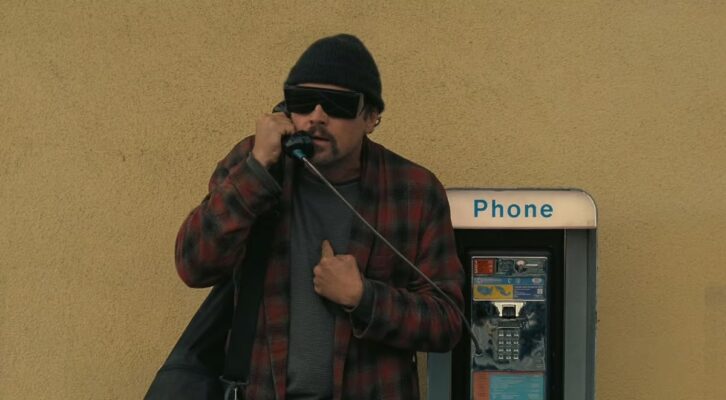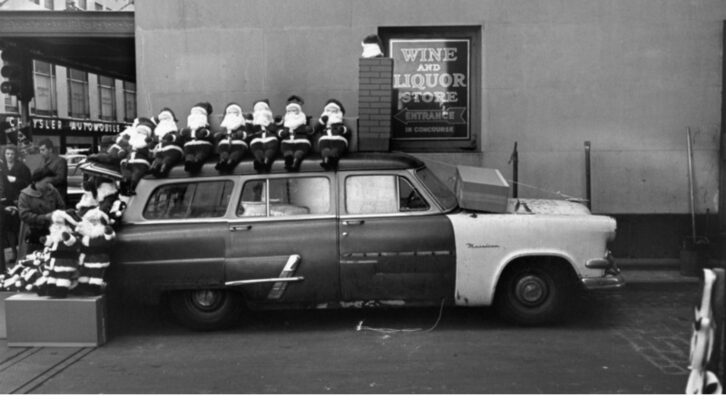Even after 60 years, Truman Capote’s controversial true crime masterpiece, In Cold Blood, remains a revelation, teeming with mystery. While many writers have mined In Cold Blood for its gay subtext, his description of John Walter Mooney’s murder remains largely overlooked.
Truman Capote introduces Mooney’s homicide as a police case with “several original touches.” However, the crime, as Capote described it, could easily happen today:
“It all started out at Stevens Park. Where they have a bandstand, and under the bandstand a men’s room. Well, this man named Mooney was walking around the park. He was from North Carolina somewhere, just a stranger passing through town. Anyway, he went to the restroom, and somebody followed him inside—a boy from hereabouts, Wilmer Lee Stebbins, twenty years old. Afterwards, Wilmer always claimed Mr. Mooney made him an unnatural suggestion. And that was why he robbed Mr. Mooney, and knocked him down, and banged his head on the cement floor, and why, when that didn’t finish him, he stuck Mr. Mooney’s head in a toilet bowl and kept on flushing till he drowned him” (p. 151)
Thus far, only Shirley Ellen Rash seems to have referenced this homicide, positing in a dissertation for graduate school that Capote included this incident to challenge a central premise of In Cold Blood. Specifically, Rash asserted that Capote wanted to show that small-town residents can be just as dangerous and lethal as outsiders, such as Richard Hickock and Perry Smith.
However, Capote specifically included and explicitly referenced a homophobic homicide. While the homophobic context in which this homicide occurs is extreme, it telegraphs the challenges and dangers Capote confronted conducting research in Kansas. While In Cold Blood focused on the rare but terrifying mass murder of the Clutter family, Mooney’s murder was an act of homophobic violence that is still commonplace across America. Although the initial newspaper reports of Mooney’s murder suggest a singular open-and-shut case, Capote, through this homicide, presented readers with a set of clues and a cadaver to explore the institutional and physical violence directed toward LGBTQIA+ people, past and present.
The “‘Murder in the Bandshell’ was almost a perfect crime but not quite,” begins the first stark line from the Hutchinson News-Herald. With a staccato rhythm, this omniscient reportage employed film noir stylistics to capture the dangers faced by gay people in America. “A perfect crime, they may have thought,” the Hutchinson News Herald continues. “No one knew Mooney. No one knew he was missing. No one in this community cared.”
The police arrested Wilmer Lee Stebens (this is the correct spelling of his name) on July 4, 1941, and charged him with second-degree murder for killing Mooney on June 24, 1941. In a series of news photographs that capture Wilmer (and his brother William Russell Stebens, charged as an accessory after the fact for helping bury Mooney) leading the police to Mooney’s body and the subsequent investigation, one photo stands out as especially compelling. In the picture, an empty stretcher awaits Mooney’s body in the foreground of a wheat field. Beyond the stretcher, a highway patrol officer with a shovel carefully excavates a body, still half-buried, from a shallow grave. The officer attends to his work with such care that he resembles a sculptor fashioning a figure from clay. At the edge of the grave, a farmer watches as Mooney is carved out of the dirt. (Only when the officer removes Mooney from the grave will the farmer realize that he accidentally plowed over the buried body a week earlier, severing an arm.) In the background, a line of fedora-topped detectives delineate the perimeter of the crime scene.
Despite this homicide’s grisly aftermath, many Kansas newspapers initially cast Wilmer as a crime victim. The Wichita Eagle paraphrased interviews with Police Chief Lee Richardson and Sheriff Al Dewey about what Wilmer said about the murder when they took him into custody. According to Wilmer, Mooney approached him, brandishing a knife and threatening “an act of sodomy.” In response, Wilmer stated that he “knocked” Mooney down a flight of stairs, beat him, and, once he realized he had killed Mooney, he enlisted his brother to help bury the body. Rather than question Wilmer, they privileged his story and repeated the salacious accusations about Mooney.
The Wichita Eagle referred to Wilmer as a “youth” to contrast his 20 years of age with Mooney’s 40 years. News stories also emphasized Wilmer’s local connections to Garden City, in contrast to Mooney, an itinerant agricultural worker from North Carolina, labeled a “transient.” Finally, newspapers clarified Wilmer’s heterosexual bona fides through references to his wife and two young children.
The scenario that Wilmer related to the police to justify his killing of Mooney constituted what is now referred to as the gay panic defense. The cultural historian James Polchin, who analyzed over 100 similar homophobic homicide cases from the 1920s to 1960s in his 2019 book Indecent Advances, identified the standard gay panic defense template that has remained constant for over a century. “Straight” men target gay men for violence and, if arrested, claim their violence was provoked by “indecent advances” from the victim. Defense attorneys then raise gay panic defenses in criminal courtrooms in pursuit of a total or partial acquittal of murder charges.
In Garden City, Wilmer followed the exact script delineated by Polchin. By claiming that Mooney threatened him with sodomy, Wilmer laid the groundwork for his attorney to argue that he killed Mooney in self-defense and, therefore, committed no crime. Yet, Wilmer had no evidence to support his story. The knife that Mooney allegedly brandished was never located. No one witnessed Wilmer’s physical altercation with Mooney. Further, the delay between the murder and police investigation ensured that the detectives were unable to inspect the alleged injuries incurred by Wilmer and Mooney.
A key element that is necessary for the gay panic defense is homophobia. In 1949, when Wilmer murdered Mooney, every state in America criminalized sodomy as a felony. Kansas criminalized sodomy as a felonious crime against nature (Section 21-907), punishable by up to 10 years imprisonment. This section of the Kansas criminal code grouped sodomy alongside offenses like bestiality and pedophilia. Kansas also criminalized same-sex intimacy as a misdemeanor (section 21-908) with local jail sentences of up to six months. The police and courts used this law—which prohibited public displays of adultery, indecency, and lewd cohabitation—to target gay men who engaged in “open” sex in “public” places such as parks and bus/train station restrooms.
During the first half of the twentieth century, Kansas also implemented draconian medical interventions against gay and lesbian people. Kansas employed a radical sterilization program—castration and ovariotomy—to prevent habitual offenders and/or those who engaged in “aberrant” sexual practices from reproducing. Kansas also sought to eradicate any possibility for gay and lesbian people to engage in sexual activity or experience any sensual pleasure. From 1894 to 1964, Kansas sterilized 3,032 people—primarily for “mental illness” (2,063) versus “mental deficiency” (citation).
Despite Kansas reporting that appeared to favor Wilmer, Mooney was beloved by his large, close-knit family. North Carolina newspapers also threw their support behind Mooney. The News and Observer in Raleigh referred to Mooney as a Tar Heel, an endearment encapsulating state pride and local loyalty. Early reporting also highlighted Mooney’s family, comprising his mother, two brothers, and eight sisters. The Winston-Salem Journal described him as “a son of Mrs. J.F. Mooney” and the Daily Times-News described him as the brother of resident Mrs. Al Hall.” The Winston-Salem Journal clarified that Mooney was not a transient, but a dependable agricultural worker who traveled to Kansas each year “to help with the wheat harvest.” North Carolina newspapers described the return of his body to “its final resting place” in Mayodan and provided the date and location of his funeral. Finally, Mooney’s family had his tombstone engraved with the following message: “Some Day We Will Understand.”
Despite the criminalization and medicalization of gay people in Kansas, Wilmer’s gay panic defense was upset by an unexpected twist. During the initial pre-trial court hearing, Wilmer’s mother, Mrs. Caroline Whitman, delivered bombshell testimony that upended both the prosecutor’s and the defense’s courtroom strategies and changed the outcome of the criminal case. Testifying for the state, Mrs. Whitman contradicted Wilmer’s self-defense claim by providing what the Kansas City Times would describe as “the most damaging testimony ever given in a local court by a mother.” While the Kansas City Times sought to denigrate Mrs. Whitman’s reputation by noting she worked in a “beer tavern,” they failed to diminish the impact of her testimony. (Kansas, the first state to implement a state-wide alcohol prohibition with a state constitutional amendment in 1881, had only ended its ban in 1948, the year before the murder.)
Mrs. Whitman testified that Wilmer told her that he tried “to crush” Mooney’s head by bumping it “several times against the concrete floor” before pushing his “head underwater in [the] restroom toilet for 45 minutes” to drown him. Garden City Police Captain Martin Craig corroborated her account by describing the lavatory’s “four walls [as] badly smeared with blood, and the toilet bowl full of [blood].”
Mrs. Whitman concluded her testimony with a chilling final image. After the murder, Wilmer, whose clothes were soaked in Mooney’s blood, stripped naked and ran two blocks through the town center to her home, carrying his bloody clothes.
This testimony not only painted a vivid and gruesome new narrative but also led to a more serious homicide charge. County Attorney Daley Corley upgraded Wilmer’s charge from second-degree to first-degree murder. Corley explained that there was now “‘reason to believe that robbery was the primary motive.’” Remarkably, Wilmer’s defense attorney sat silently throughout Mrs. Whitman’s testimony without raising a single objection.
While Finney County had not prosecuted a first-degree murder case in 30 years, the criminal courts took steps in advance to prepare for Wilmer’s trial. Finney County hired a local private attorney, Logan Green, to assist the County Attorney. The County Attorney also arranged for the state to be able to call 22 witnesses to the stand, including two of the victim’s siblings, Thel (25) and Riley Mooney (38), who were traveling approximately 1,335 miles from North Carolina to testify in Garden City.
In his opening statement, County Attorney Corley informed the jury that he would prove that Wilmer committed first-degree murder and instructed them to be prepared to place a hangman’s noose around Mooney’s neck. The state’s case relied heavily on Wilmer’s own family. Both his mother, Mrs. Caroline Whitman, and his brother, William Russell Stebens, provided devastating testimony.
When the defense presented their case, Wilmer took the stand to offer an account of the homicide that deviated from his original police statement. Wilmer claimed he met Mooney within his mother’s beer tavern, and that Mooney tried to “mooch” a beer from him before making a sexual overture. “Mooney invited me up to his room to have some fun,” Mooney told the court. “Because of that, I tried to stay away from him.”
Wilmer next testified that Mooney invited him to share a bottle of whiskey he had hidden within Stevens Park. When Wilmer followed Mooney into the park, Mooney was unable to find the whiskey. At that point, Wilmer said that he went to the bandstand, descended the steps into the bathroom, and Mooney followed him, “mumbling.” In describing the killing, Wilmer said, “I turned, saw Mooney with a knife in his hand, and grabbed his arm. I threw him to the ground, and we fought. After the fight, I threw the knife across the street.”
To counter the County Attorney’s robbery allegation, the defense introduced two “surprise witnesses.” Local farmer George L. Meeker testified that his son, Wilbur, had given Mooney a cash advance of $2.00 ($1.50 for a room and 50 cents for a meal) just hours before the murder because Mooney had no money. Wilbur Meeker corroborated his father’s testimony.
Wilmer’s wife, Wanda, testified too, claiming her husband had a knife scar on his torso when he returned home—evidence, she argued, that Mooney had attacked him with a knife (that was never found).
After the defense rested and closing statements were made, the jurors took a break for dinner. Upon returning to the court, the jury deliberated for less than an hour. Back in the courtroom, the jury stated that they had found Wilmer guilty of first-degree murder but defied the county attorney’s demand for the death penalty, opting instead for life imprisonment. At the verdict and sentencing, both Wilmer’s wife and mother wept.
Serving his prison sentence, Wilmer revealed a dangerous cunning that was similar to that of Richard Hickock and Perry Smith. He escaped twice from prison in 1950 (for ten days) and 1969 (for three days). After breaking out of prison, he would hot-wire cars and drive hundreds of miles, seeking to elude the law through the anonymity of highways and interstates. During his 1969 escape, he kidnapped a 21-year old woman, drove her to a secluded location, where he raped her at knifepoint, before releasing her.
In a strange postscript, a reporter interviewed Wilmer in 1981. Wilmer discussed Truman Capote’s description of how he murdered Walter Mooney. While Wilmer seemed to have memorized Capote’s account of the killing, he snorted and labeled it as “not true.”
Kansas paroled Wilmer in 1988, and he died in 2002 at the age of 73.

















